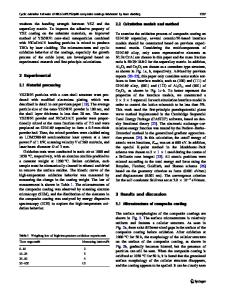Properties of laser fabricated nanostructured Cu/diamond-like carbon composite
- PDF / 446,765 Bytes
- 11 Pages / 584.957 x 782.986 pts Page_size
- 69 Downloads / 360 Views
H.Y. Ng Department of Civil & Environmental Engineering, Faculty of Engineering, National University of Singapore, Singapore 117576, Singapore (Received 16 May 2011; accepted 25 August 2011)
Copper/diamond-like carbon (DLC) was fabricated using pulsed laser deposition, and the effects of copper on the properties of DLC composites were studied. Experimental results showed that the presence of copper promoted surface evolution through the formation of nanoclusters, accentuated the formation of Si–C but graphitized the diamond bondings of DLC matrix. By considering the interaction of laser with copper/carbon composite target, the presence of copper may have increased the energy absorbed during laser deposition, as envisaged by Saha’s equation. Thus, upon the impingement of ions on substrate during deposition, the carbon and silicon atoms may have been redistributed to form Si–C bonding while the excess energy was released as heat to promote the formation of nanoclusters but graphitize the sp3 bonding in DLC. Although sp3 bonding was reduced with the presence of copper, mechanical characterization showed that the adhesion strength of the composite films was approximately five times higher compared to undoped DLC, as a result of the decrease in internal stress and the formation of Si–C bondings in DLC. I. INTRODUCTION
Diamond-like carbon (DLC) has been subjected to intense research over the last three decades owing to its interesting material properties such as excellent hardness, high chemical inertness, wear resistance, thermal conductivity, optical transparency, and low coefficient of friction (COF).1 With these attractive properties, DLC has found many important applications such as structural elements in micro-electromechanical systems, protective coating in magnetic storage disk, and biocompatible coatings for medical applications.1 In the application of protective coating, the reliability of the coating is often governed by the adhesion and tribological properties of the films. At macroscopic scales, as suggested by Amonton’s law, the friction coefficient is independent of contact area and applied load.2 However, as the critical dimension for devices continues to shrink, the surface forces such as adhesion, friction, meniscus forces, viscous drag forces, and surface tension become more dominant compared to volumerelated forces such as inertia or electromagnetic forces.2,3 The breakdown of Amanton’s law at nanoscale means that the individual asperities on the surface of films should be taken into consideration and can affect the reliability of the a)
Address all correspondence to this author. e-mail: [email protected] DOI: 10.1557/jmr.2011.318 J. Mater. Res., Vol. 26, No. 21, Nov 14, 2011
coatings. For example, Gabriel et al. in their early study showed that wear is one of the dominant failure mechanisms for polysilicon microturbine and gears, while Lee et al. showed that the lifetime of microfabricated radialgap electric motor was limited to 10,000 cycles due to high friction and wear of nitride polysilicon bearin
Data Loading...










